Nuances of use and tips for choosing
Before buying, you need to carefully check the marking of the equipment. It must be stated that it is intended for drywall
It is also necessary to pay attention to the fact that the markings on the elements and bits coincide. It is best to purchase self-tapping screws with a Phillips head and a diameter of 3.5 mm, bit marking - PH2
If the caps have an eight-pointed slot, then you should choose another bit - the PZ standard.
The bit length depends on the purpose of the application. If you need to install the gypsum board only on one wall, then it is enough to buy a short rig with a limiter. To tighten screws in corners, under shelves and in other hard-to-reach places, it is better to purchase a longer bit.
The service life of a tip depends on the material from which it is made. Professional builders speak well of tooling made from the following alloys:
- chromium and vanadium;
- chromium and molybdenum;
- tungsten and molybdenum.
Very often there are fakes brought from China. For one-time and short-term use, you can buy something at a low cost.
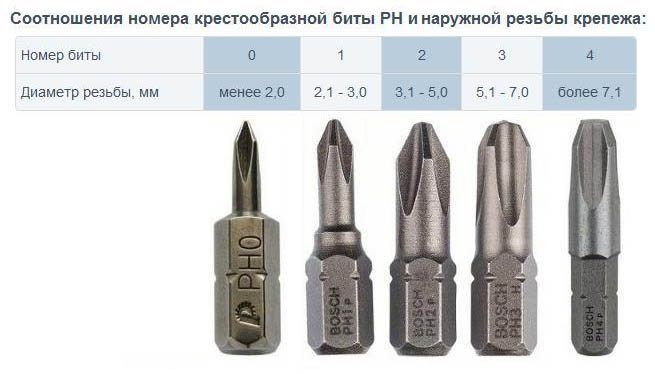
For convenience, some bits, in addition to the limiter, have a magnetic holder, thanks to which the mounts do not need to be held in your hand. To check the quality of this part, the bat is dipped into a handful of self-tapping screws. After lifting, at least three elements should remain on it.
To increase the service life, various protective layers are applied:
- The nickel plating will prevent the alloy from rusting.
- Diamond plating increases wear resistance.
- Tungsten carbide layer increases strength.
- Titanium coating protects against damage.
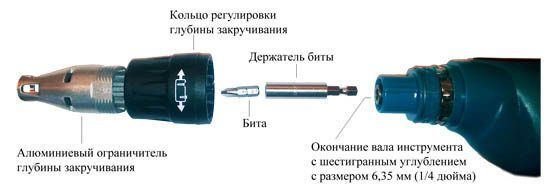
In addition to helping speed up workflow and improve structural strength, the bit has other benefits. The risk of going through the sheet is negligible. This characteristic is especially convenient for those who use such equipment for the first time, since they do not know how hard it is to press on a drill or screwdriver. All screws are obtained at the same level. As a result, it will be convenient to cover with finishing materials, since nothing sticks out, and there are no large depressions.
Even high-quality nozzles have a low cost - in the range of 200-220 rubles. For example, Skrab 43695 with a length of 50 mm costs 210. The bit is made of heat-treated stainless tool steel and covered with an anti-corrosion layer. Gross 50 mm long is made from an alloy of molybdenum and chromium, equipped with a magnetic holder, the cost is 220 rubles.
Requires minimal tool handling skills. Before proceeding with the repair and fastening, it is best to practice well on unnecessary building materials. This equipment fully justifies the funds spent on it, since you do not have to spend time, effort and money on installing new sheets to replace the damaged ones. Skirted bits can also be used on softwood, chipboard and fiberboard.
Adequate selection of self-tapping screws and their varieties
When selecting fastening material, first of all, the emphasis should be on the quantity and type for each type of work, that is:
- For fastening the rafters, galvanized self-tapping screws are used.
- For lathing - special roofing type and with a press washer.
After determining which screws are relevant, the potential purchase should be checked for compliance with the declared quality:
- When making self-tapping screws, the plant puts its own stamp on each fastener. If it is not available, there is a high probability of purchasing a cheap fake.
- Each box of self-tapping screws should carry information about the thickness of the coating applied. The minimum value is 12 microns.If the box, or there are no indications of the characteristic, this is clear evidence of a discrepancy in quality.
In total, there are two types of roofing fasteners, for wood and metal. They differ from each other in the type of thread, diameter and tip. Those elements of the roof that do not have direct contact with moisture can be fastened with self-tapping screws equipped with a press washer.
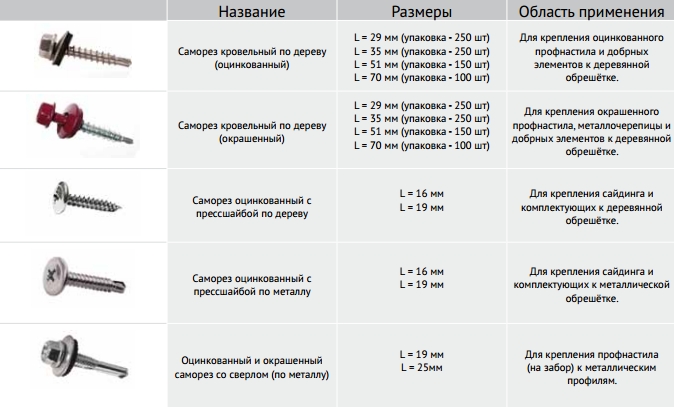
When installing rafters and other elements, the surface to be installed and the wooden base of which has a large distance, are usually used for wood screws with incomplete threads. Technically, self-tapping screws can differ in the form of coating - painted and galvanized.
All roofing screws for wood according to GOST have the same diameter - 4.8 mm. The size of the fasteners can be - 29, 35, 38, 60, 65, 70 and also 80 millimeters. Self-tapping screws with a length exceeding 60 mm are most often used when fastening corrugated materials. In this case, the material is attached to the upper point of the wave, as in the case of slate.
For roofing screws for metal and coming from the purpose of destination, the diameter can vary from 4.8 to 6.3 millimeters. For small-diameter fasteners, the length can be from 16 to 80 millimeters, and longer ones - from 19 to 150. If metal-to-metal fastening is used in roofing work, then this is done using self-tapping screws less than 29 mm long.
In the case of working with a multilayer type crate, fasteners from 80 mm are used.
Stainless self-tapping screws and screws
Wood grouse DIN571 plumbing screw (A2, A4)
The stainless steel wood screw DIN 571 is made of steel A2 or A4. Designed for fastening wooden logs, beams, slats and other wooden substructures. It is possible to use a bundle of screw + plastic or metal dowel. Quite often used in conjunction with a reinforced washer.
Roofing self-tapping screw DIN 7504K (standard drill) (A2, A4)
Stainless self-tapping screw DIN 7504K is designed for fastening various metal structures without pre-drilling holes. The hexagonal head is equipped with a pressed-in washer. Made of steel A2 or A4.
Countersunk self-tapping screw DIN 7504O (A2)
Self-tapping screw from stainless steel A2 DIN 7504O countersunk head, Philips slot. Designed to work on metal, aluminum, stainless steel without pre-drilling. The tip is drilled.
Self-tapping screw with a semicircular head DIN 7504M (A2, A4)
Self-tapping screw DIN 7504M from stainless steel A2 or A4 is intended for fastening structures in conditions of increased aggressiveness of the environment. It is intended for fastening sheet materials made of various metals (stainless steel, galvanized, aluminum, sheet metal, etc.). Equipped with a drill and does not require additional drilling during installation.
Screw DIN 7976, hex head (A2)
Stainless screw DIN 7976 (steel A2) is ideal for use in conditions of increased aggressiveness of the environment (moisture, reagents, dirt, etc.). Used for fixing sheet materials such as plywood, plastic, metal sheets, etc. The head has the shape of a hexagon, is designed for a turnkey or a special attachment.
Screw DIN 7981, semicircular head, slot PH (A2, A4)
The stainless steel screw DIN 7981 is made of steel A2 or A4. Resistant to aggressive environments. Used for fastening plywood, plastic sheets, stainless steel sheets and other sheet materials. Due to the semicircular head, maximum sheet pressure is ensured. Philips slot.
Wood screw DIN 7981, semicircular head, slot Z (A2)
The DIN 7981 screw is made of stainless steel, galvanized. Equipped with a semicircular head with a Z-slot - a cruciform, sharp tip. It is used for fixing wood, sheet materials, metal.
Screw DIN 7982, countersunk head, slot PH (A2, A4)
Screw DIN 7982 made of stainless steel A2 or A4 is designed for fastening various parts in an aggressive environment.Suitable for both wood and metal structures, however, to screw into metal parts, you must first drill a hole. Countersunk head, Philips slot.
Screw DIN 7982, countersunk head, slot PZ (A2)
Screws DIN 7982 have a countersunk head, slot PZ (cross). Production material: stainless steel. When screwing into wood, plastic, no pre-drilling is required.
Screw DIN 7983, half-countersunk head, slot PH (A2, A4)
Stainless screw (A2 / A4) DIN 7983 is used for operation in conditions of increased aggressiveness of the environment (water vapor, salts, alkalis, acids, etc.). Allows to fasten wood, plastic and metal (with preliminary reaming) structures. Semi-countersunk head with Philips slot.
Self-tapping screw & quot; Klop & quot; cross recess (A2)
Self-tapping screw "Bedbug" is used in construction to obtain high-quality fastening, equipped with a drill, which makes it possible to fasten metal without preliminary drilling. The head has a cross recess washer. Production material: stainless steel A2.
Self-tapping screw with hexagon socket (A2)
The self-tapping screw DIN 912 has a cylindrical head with a hexagon socket. Production material: stainless steel, coating: galvanized. Scope of application: mechanical engineering, construction, repair, installation.
Drywall Screwdriver Bits: Stopper Bits
Penetration Restriction Bits Available for Various Material Types
When buying, you need to pay attention to the labeling. The nozzle must be designed specifically for drywall, otherwise there is a risk that the material will be damaged
You also need to pay attention to match the markings of the bit and the caps of the screws. Otherwise, the work will be uncomfortable, the risk of damage to the screws, the attachment and even the power tool itself will increase.
Bits marked PH 2 are suitable for standard black 3.5 mm self-tapping screws for drywall with a cross-recessed head. Additional coatings increase the service life of the product: nickel protects against corrosion, titanium protects against various mechanical damage, diamond plating makes the bit wear-resistant, and tungsten and carbide add strength.
Regardless of the value of the force set on the screwdriver, the risk of passing the gypsum board through and through is reduced
This is especially important for novice craftsmen who are not yet accustomed to the tool and do not know how much effort is enough to tighten the screws tightly, and which will be excessive.
When working with drywall, you can easily squeeze a self-tapping screw, due to which the sheets of material are damaged: cracks appear on the gypsum or the cardboard breaks from the outside. In some cases, the cap can go through the gypsum board, as a result, the sheet will not be pressed against the profile. In any case, due to pinching, the entire structure noticeably loses in strength and reliability.
A drywall bit with a stop will avoid these problems.
Recommendations for choosing bits for work
The market for attachments designed to equip a screwdriver is filled with products of different quality and from different companies. For this reason, the question is relevant: which manufacturers should be purchased as a set, and which separately? The correctness of choice in this case determines not only the time of using the purchased bits, but also affects the service life of the power tool used, and also affects the quality of the work performed.
Tips for purchasing piece goods
For a piece purchase, experts recommend Whirl Power (WP) brand products. It is easy to distinguish it from analogs by the presence of a branded green sticker. The products of this company have earned great popularity and authority due to their good magnetic properties, as well as significant hardness, which increases the operating time due to slow wear.The attachments are easily inserted into the chuck without falling out of it when the power tool is tilted down. Magnetic bits hold metal fasteners well - this allows you to conveniently perform work in hard-to-reach places.
For practical use, the following Whirl Power bit sizes are popular:
Long 150 mm nozzles are also widely used.
To work with most types of fasteners, standard WP2 models are used. If you need to perform operations with decorative modifications of self-tapping screws, then use tips for the WP1 screwdriver. The working parts are equipped with notches that increase their resistance to wear.
The products of Bosch, which traditionally supply high-quality power tools to the market, are practically not inferior to Whirl Power in popularity among buyers. The quality of screwdriver bits from this brand is also emphasized by their high price. At the same time, titanium coated products, marked with yellow, are especially popular. The main material for their manufacture is chromium vanadium, tungsten-molybdenum or chromium-molybdenum alloys. In addition to titanium, tungsten carbide, diamond or nickel are also used as a protective coating for the nozzle working parts.
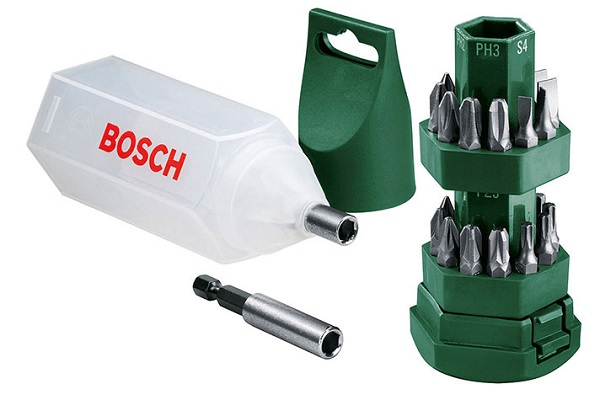
Cheaper competitors of Bosch are hardware from DeWALT. Their distinctive feature is a high degree of shock resistance. They can be used regularly for a long time. For household use, Magna hardware is also suitable. With careful work, they can last a long time.
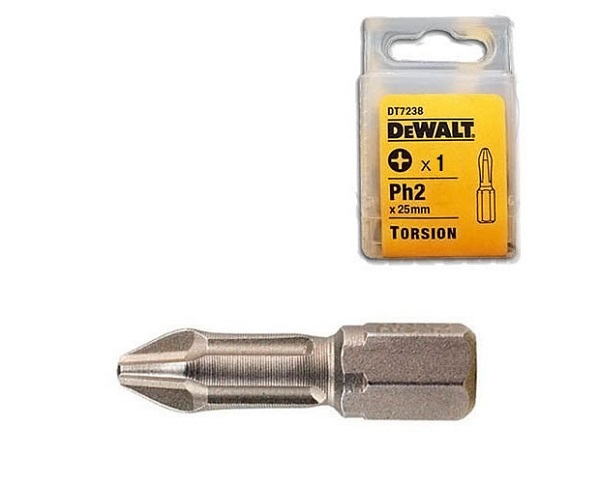
Bit torsion Ph2, Extra Grip L 25 mm DeWALT DT72381
If you need to buy equipment for a certain type of fastener, it is recommended to take a sample of it with you. This will allow you to choose the best tip option by trying it on the cap prior to purchasing.
Popular attachment kits
You can choose bits for a screwdriver in one set. In stores, there are many ready-made selections of hardware, packed in boxes convenient for storage and use. In such cases, each element is placed in a separate place, while indicating its size next to it.
Among the competitors, professional nozzle kits from Hitachi and Kraftool stand out for their excellent quality. They contain hardware of all standard sizes used in various fields of practice.
If you buy a set of high-quality hardware, then such a purchase will cost less than a piece purchase of a similar product. Buying a set, allowing you to save money, is very convenient in the implementation of professional activities.
Despite the wide variety of shapes of working tips for a screwdriver and the differences in the material from which they are made, in any case, you should choose high-quality accessories. Purchasing products from well-known brands that have proven themselves well over the years is the right decision for professional activities and with large regular volumes of work performed. Such products will last for a very long time, contributing to the efficient performance of labor tasks. Low quality, cheap kits can be purchased for domestic use. But it should be borne in mind that they wear out quickly, causing a lot of inconvenience during the working process.
Roofing screws
Self-tapping screws with a hexagonal head have a wide range of applications, but most of all they are used for fastening such roofing coverings as metal tiles and corrugated sheets, as well as accessories for them, for which they received the generalized name "roofing".
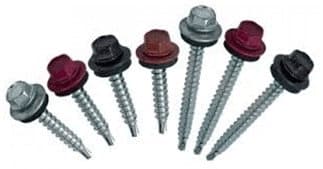
- The length of self-tapping screws with a hexagonal head is from 19 to 100 mm.
- Shaft diameters 4.8 and 6.3 mm.
They are completed with a washer with a rubber gasket, which is responsible for the tightness of the connection, which is important for the roofing device (so that there is no leakage).
According to the color variety, hats can be of very different colors: red, brown, green, white and others. The color of the cap is matched to the color of the material to be fixed and is marked according to the Ral and RR color standards.
There are also self-tapping screws without painting - just with a galvanized head and a washer.
To fasten (tighten) these self-tapping screws, bits with an internal hexagon are used.
Bit size:
- for self-tapping screws with a rod diameter of 4.8 mm - 8 mm bit
- with rod diameter 6,3 mm - bit 10 mm
Confirmat - furniture screw
.
Confirmates are used when assembling furniture.
The most used are 50 mm long with a hex head.
This type of fastener requires mandatory pre-drilling. For this, there is a special confirmation drill.
For screwing the confirmations, use hexagons or bits for HEX 4 screwdrivers.
Construction wood grouses
Capercaillie is a thick-rod self-tapping screw with a hex head.
Capercaillies are widely used in fastening various units of heavy structures, where special strength and reliability of the connection is required.
In the construction of pitched roofs, wood grouses are used for wooden truss systems and interfloor floors.
- The thickness of the rod for the wood grouse is from 6 to 10 mm.
- The size of the hexagonal head for wood grouses is from 10 to 19 mm.
They are tightened by hand with wrenches of the appropriate size, or with attachments using ratchets or an electric tool. Pre-drilling may be necessary.
For fastening to bases made of concrete, foam block bricks, etc. - they are used together with a plastic dowel.

Cross Bits (Pozidriv)
Later, specifically for the production of furniture and construction work, the Philips Screw Company developed a new type of cross recess. It was named Pozidriv (Pozidriv). This type of slot was patented in 1966. The bits for this slot are marked with the letters PZ. They are designed to work with wood or other similar materials that have a heterogeneous structure. At the same time, bits of the PH type are more suitable for working with metal.
A distinctive feature of the PZ system, in comparison with PH, is that the edges of the working surfaces are parallel to each other and are made with the same thickness along their entire length, and the slot itself is much deeper. This design feature prevents the bit from being pushed out when the fastener is tightened. This creates a tighter contact between the screw head and the bit, which reduces wear on the elements. In this case, it is not necessary to apply large axial forces when the tip is pressed onto the slot.
It must be remembered that when choosing a bit for tightening fasteners for the PZ slot, you must use a PZ type bit. In the case of using a PH type nozzle for twisting products under the PZ slot, the surfaces will loosely contact each other, which will shorten the service life of the nozzle.
Classic cruciform bit PZ with notches
Extra notches are the hallmark of PZ bits when compared to PH bits. The great strength of the devices allows them to withstand enormous loads. The sizes of this type of bit for a screwdriver can be PZ 1, PZ 2, PZ 3.
PZ cross-head bit with serrations and TIN coating
The protective coating of this nozzle is made on the basis of titanium nitride. It greatly improves the durability of the bit. This is also facilitated by the hardened steel used for its manufacture. All this together made it possible to create a nozzle with optimal hardness and endurance. There are three attachment sizes: PZ 1, PZ 2 and PZ 3.
Drywall screwdriver bits
PZ (Pozidriv) bits are executed with strictly parallel edges. This shape ensures that the screw is retained in the head at all tightening forces.Visually, these types can be distinguished by the presence of additional protrusions between the edges or small grooves on the screw head at an angle of 45 degrees with respect to the main splines. The slight non-parallelism of the PH (Philips) slots is made so that, with a certain force when twisting, the edges are pushed out of the screw head.
This shape contributes to the self-centering of the tool in the slots of the head, even when the tool is at a certain angle. Bits for drywall screwdriver are produced exclusively by PH. As mentioned above, the bit size is 2. Thus, the inscription on the instrument should be PH2. As a rule, those devices that come with a screwdriver are of a rather poor workmanship and serve only to familiarize themselves with the capabilities of the tool. All quality add-ons must be purchased separately.
For work with a screwdriver, various devices are produced that differ not only in geometric dimensions, but also in the shape of the slots. The most widespread are bits with edges of the PH and PZ types. The inexperienced eye will not see much difference in them, except for additional protrusions on the tool with the inscription PZ.
The difference lies in the geometry of the splines. A bit for a drywall screwdriver has a slot plane at a slight angle to each other. For PZ, they are strictly parallel.
Bit with a limiter for drywall: advantages of use
A bit with a limiter for the installation of gypsum boards is a special type of attachments that do not allow the self-tapping screw, when screwed with a drill or screwdriver, to damage the gypsum board. The stopper resembles a cup that is larger than the bit head. When twisting, the protective element rests on the sheet and does not allow the cap to penetrate into the body of the gypsum board. Thanks to such a limiter, the master does not have to worry about the self-tapping of the self-tapping screw.
You should be aware that limit bits are produced for different types of materials, and this is indicated by the markings on the product. If work is carried out with gypsum board, then the nozzle should be chosen specifically for this type of building material, otherwise the likelihood that the sheet will be damaged increases significantly. quality of fasteners. The only thing that is needed is the minimum experience and skills in working with the tool, because it is impossible to screw in the self-tapping screws with your own hands: for this you need to use a drill or screwdriver. In any of these cases, the consequence of the pinching is the loss of strength, and hence the durability of the structure.
And only a bit with a limiter for drywall will help prevent such problems. Mounting drywall sheets (gypsum plasterboard), you can easily damage the product by accidentally pinching the self-tapping screw. As a result, cracks that weaken it form in the gypsum body, or the top layer of cardboard is damaged.
Sometimes the head of the self-tapping screw goes through the gypsum board, as a result, the canvas is not fixed to the metal profile in any way.
Types and marking of bits
PH - short for Phillips
The bit has cross-slots, widening near the shank and forming an angle of 55 degrees at the apex, is clearly and securely inserted into the screw head.
Screwdriver device.
Sizes from PH0 to PH4. The number in the marking indicates the size of the cross. The larger it is, the larger the bit is for the larger self-tapping screw. Bits in size PH0-PH2 are used for the most common screws with a diameter of 2.5-3 mm. PH4 is rarely used in the repair and installation of large-sized structures in the automotive industry.
The most popular bits are PH2 and PH3, they are most often used for screwing all types of black screws, including for twisting thin-walled metal profiles - "bugs".
The PH standard is universal, suitable for most other types of self-tapping screws.
PZ - short for Pozidrive
Bits are used for screwing self-tapping screws with Pozi standard splines and medium thread pitch and universal countersunk (UP).
It is a cruciform bat with 4 large ribs and 4 additional diagonal ribs forming a "double cross". The apex angle is 50 degrees. This design provides a larger grip area than PH bits.
The torque transmitted from the screwdriver to the bit and then to the screw or self-tapping screw will be much higher.
Before changing the screwdriver attachment, check that it is disconnected from the mains.
In most cases, PZ bits are used to remove rusted or seized screws.
Bits of this type are indispensable for screwing screws into materials with a dense structure, such as hard wood, compressed artificial materials. They can be twisted at an angle. The screw heads and bits are not damaged in this case.
Sizes from PZ0 for self-tapping screws with a diameter of 2.5 mm to PZ4 for self-tapping screws with a diameter of more than 4 mm and anchor bolts. The most popular sizes are PZ2 and PZ3.
Torx hole
Bits of this type are called "asterisks". Provides reliable adhesion to the heads of bolts and screws, eliminating slippage. They are used where a lot of effort is needed to tighten fasteners.
Head bolts of this type are most often found in cars, household appliances.
There are two types of markings, for example Torx8 or T8. The diameter is indicated in mm.
Bits from T8 to T40 are suitable for the screwdriver. In various electronic devices, there are also smaller sizes, but working with a screwdriver with such bits will not work, you need to use a screwdriver.
Torx hole sprockets may have an internal hole.
SL - short for Slot
Standard SL - screwdriver with flat straight slot of different widths, measured in mm.
Marking, for example SL6 or Slot6, means: 6 mm flat-slotted bit.
Sizes from SL0 to SL7.
They differ in the length of the rod. They can be with or without a limiter. The limiter is used so that it is not possible to wrap the fasteners deeper than necessary, for example, when installing drywall. Bits of this standard are used when screwing fasteners in soft materials when a large torque is not required. Cannot provide a secure grip on the head of a screw or screw.
How is fastening carried out
Many technical points during fastening work depend on what kind of materials are used for this. The type of material, its thickness and even what kind of crate is used can also affect.
First of all, you should carefully read the instructions for fixing certain materials. After that, the length of the fastener is selected, which should be more than the resulting total thickness of the fastened elements by at least 3 millimeters.
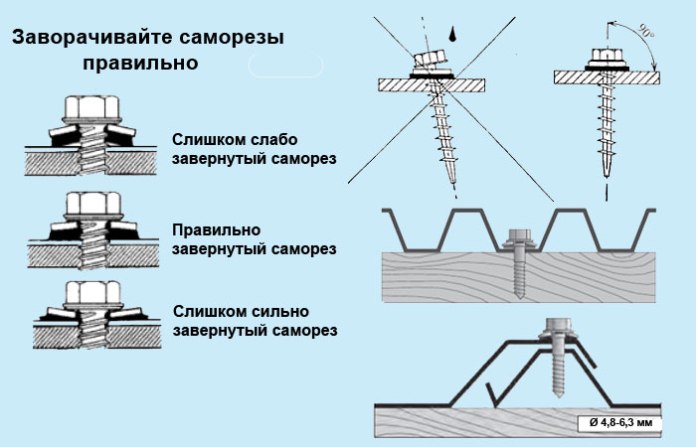
After that, you must first drill a hole and tighten the self-tapping screw. Screw in self-tapping screws with a screwdriver, screwdriver, wrench or hexagon in the form of a nozzle on an electric drill.
If you use electrical tools when carrying out roofing work, then the productivity of the work increases many times over.
The self-tapping washer must be firmly pressed against the gasket, but do not use brute force when fastening.
Because of this, a fragile roof can be damaged and the fastening with the base can break off. If power tools are used in the work, we recommend those devices that have rotational force regulators.
As for the preferred attachment points for common types of roofing materials:
- The metal tile and the profiled sheet should be fixed in those places where the maximum contact between the material and the crate occurs, that is, at the very bottom of the wave.
- With slate, everything is different. It must be fastened at the highest point of the waves.
Other materials, such as those that are attached at large angles to the horizontal, are fastened in overlaps that are invisible to the eye.
Bit types
The screwdriver accessory consists of the following accessories:
- magnetic or conventional bits and holders for them (extension cords);
- drills.
The bit is a rod with six faces, on one side of which there is a working profile, and its other end is intended for fixation in the chuck of the power tool or in the holder. This special nozzle should correspond in size to the type of fastener (self-tapping screw, screw, screw, bolt, etc.).
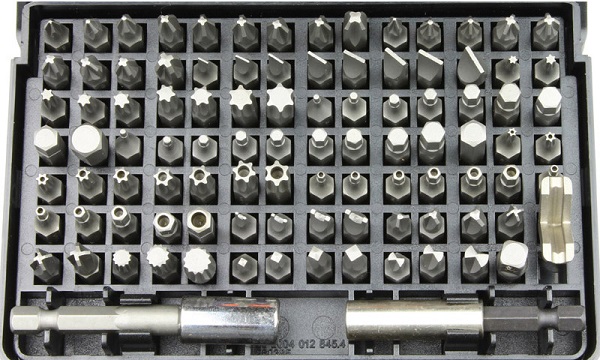
Drills for a screwdriver represent a separate category of accessories. They are taken from conventional (hammerless) drills. In this case, the maximum diameter of the drills is limited by the largest section of the tail part, which the tool holder can clamp.
The existing types of bits differ in the shape of their working part. On this basis, such groups of this equipment are distinguished:
- basic (standard), which includes straight, cruciform, hexagonal tips, as well as in the shape of an asterisk and for bolts;
- special, for example, bits equipped with spring clips, limit stops (designed for screwing drywall sheets), triangular;
- combined, in which the attachments are equipped with two working parts of different shapes or sizes.
Bit extenders are divided into two types:
- magnetic, holding the inserted nozzle due to the strength of the magnetic field;
- spring, in which the tail is fixed rigidly.
Standard equipment
Standard nozzles are included in any set, they are used most often in work. The very first of all the variety of accessories appeared straight (slotted) bits. This classic version is designed to work with screws or screws that have a straight cut. The slotted equipment is marked with the letter S (from the word slot), next to which a number is placed. The number indicates the slot width, which is between 3-9 mm. Nib thickness is not specified, but is typically 0.5 to 1.6 mm. The marking located on the shank also contains an indication of the material from which the tooling is made.
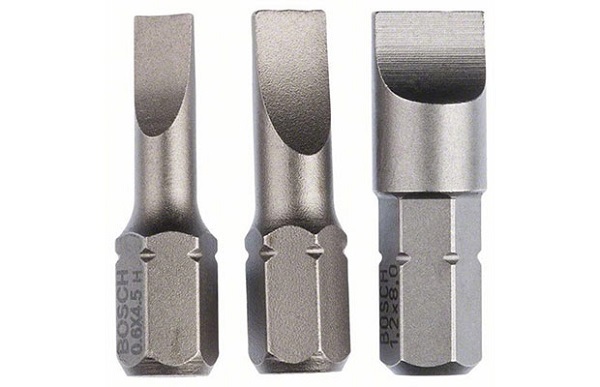
There are slotted bits with gold titanium nitride plating. Then the marking contains the TIN designation. In this case, the width of the tips with titanium coating can be from 4.5 to 6,% mm, and the thickness - 0.6-1.2 mm.
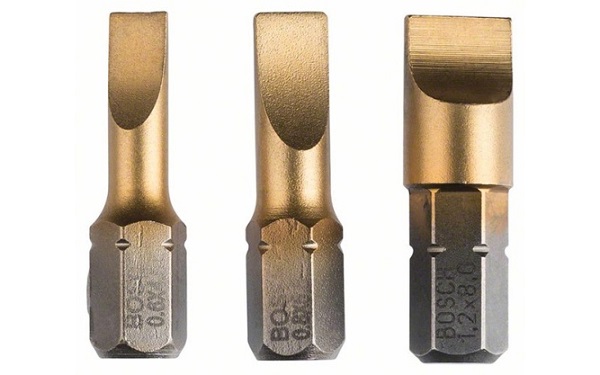
There are elongated slotted nozzles. They are 5-10 cm long.
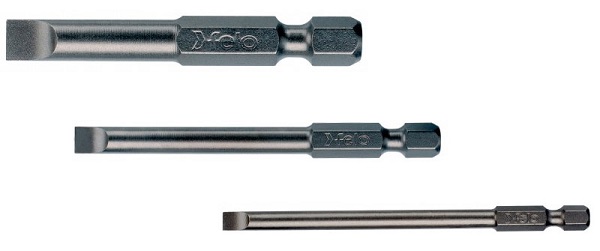
The cruciform (cross) bits are divided into two groups:
Ph (from Philips) - a universal type with a length of 2.5 to 15 cm (there are also 30 cm flexible holders), with a working part of four diagonal ribs;
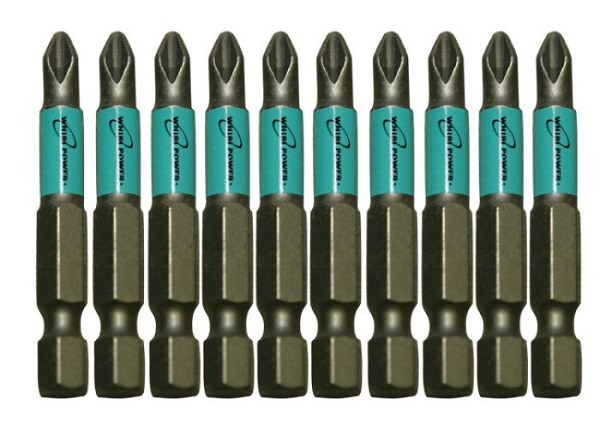
PZ (Pozidrive) is a rig of different lengths, equipped, in addition to 4 main ribs, with four additional ribs.
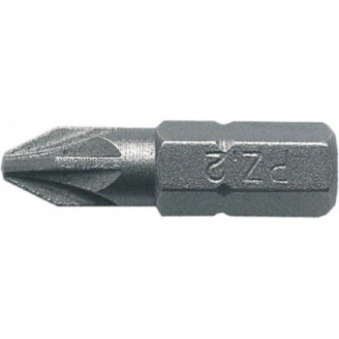
Philips accessories are available in four standard sizes: from Ph-0 to Ph-3. The number corresponds to the outer diameter of the fastener.
Pozidrive attachments are available in the following sizes:
- PZ0 are used to work with screws up to 2.5 mm in diameter;
- PZ1 - they are used to tighten fasteners from 2.5 to 3.5 mm;
- PZ2 are designed for screws 3.5-4 mm;
- PZ3 and PZ4 handle large screws and anchor bolts.
The cruciform harness is the most common in comparison with the rest of the varieties. It can also be titanium coated.
Hexagonal bits are marked with the letter H (from the phrase Hex socket). Such nozzles can be:
classic type, size 1.5-10 mm;
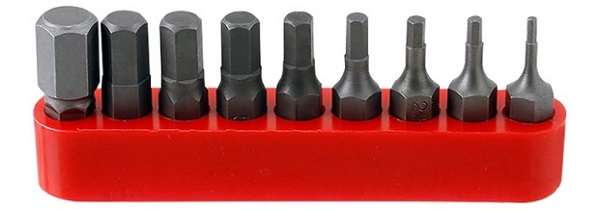
hexagonal shape, but with an internal hole (their dimensions are in the range of 1.5-6 mm);

elongated, with the dimensions of the working part from 3 to 8 mm and a length of 5-10 cm.
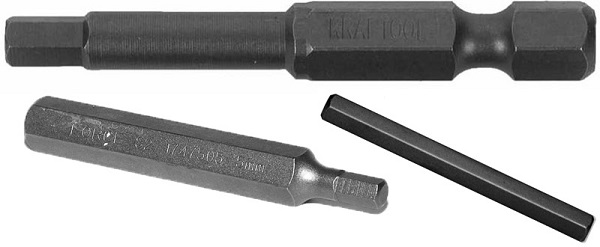
Asterisk bits are marked with a T followed by a number. They are used in the assembly / disassembly of household appliances, as well as cars. They come in the following varieties:
Torx (classic), sizes T8-T40;

Torx Plus (their rays are less sharp), standard size from T10 to T40;

with titanium coating (TIN), sizes T10-T40;
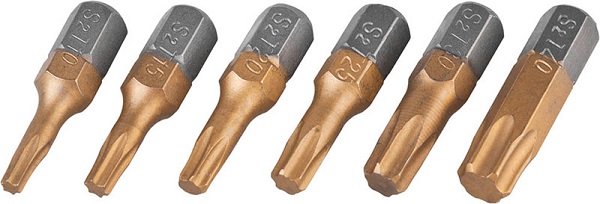
with an internal hole (standard size T10-T40);

elongated: from T10 to T40 in size, 5-10 cm long.
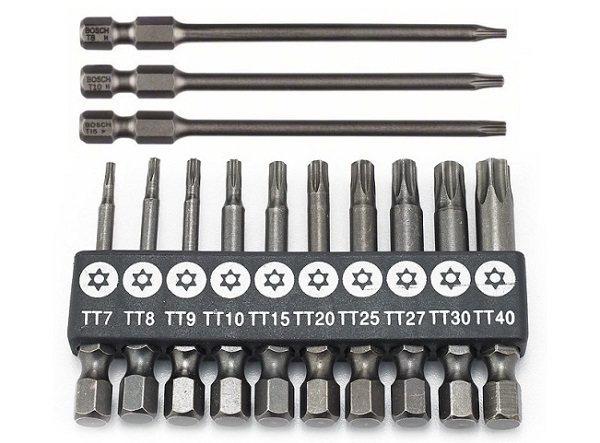
The attachments designed for tightening or untwisting of fasteners with a hex head (bolts, nuts) have a size of 6-13 mm.The most common of these are 8mm bits.
Special attachments
Special equipment includes the following types of bits:
three-bladed (Tri wing), standard sizes TW0-TW5;
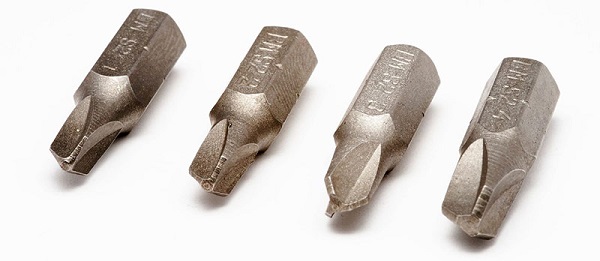
four-bladed (Torq-set, designated Gr), 4-10 mm in size;

classic and elongated tetrahedral (Robertson square, with a square slot), denoted by the letter R;
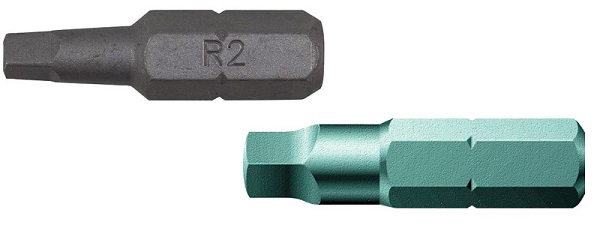
elongated and classic in the shape of a "fork" (designated Gr).

There are also tips with a different special shape, but they are rarely used.
